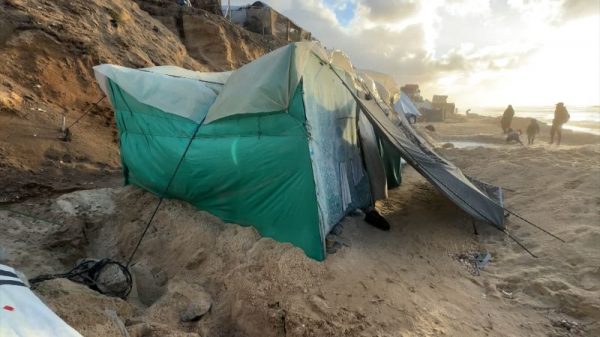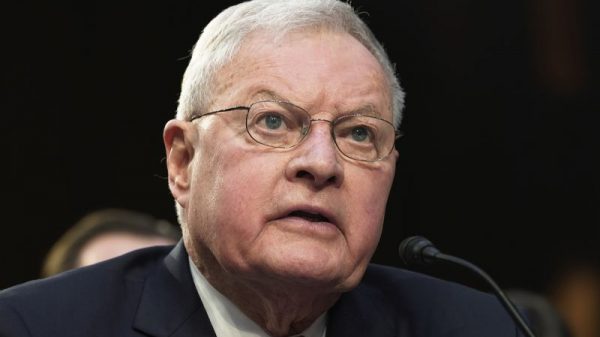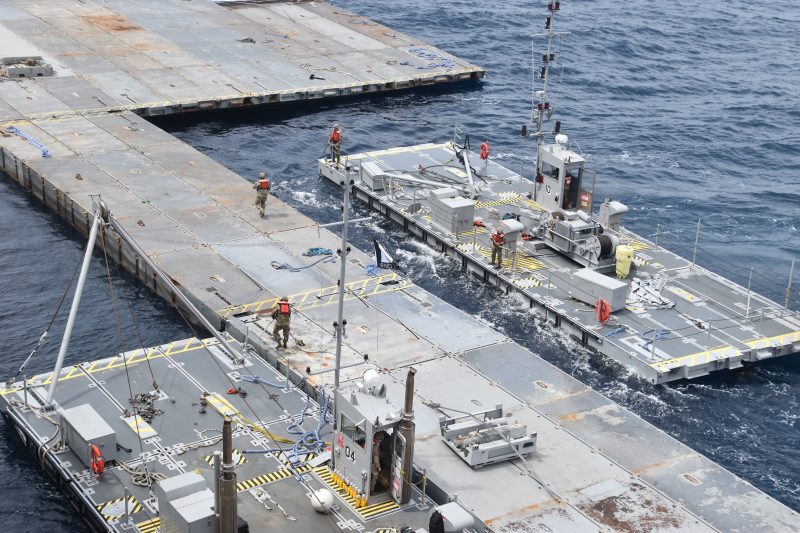President Joe Biden approved the plan for delivering humanitarian aid to Gaza via a floating military pier despite warnings from within the U.S. government that rough waves could pose significant challenges and objections from officials who feared the operation would detract from a diplomatic push to compel Israel to open additional land routes into the war zone, according to an inspector general report published Tuesday.
The watchdog for the U.S. Agency for International Development (USAID), which oversees Washington’s humanitarian work abroad, cited various “external factors” that it said impaired the agency’s effort to distribute food and other supplies brought to Gaza over the pier. Among them, according to the report, were the security requirements imposed by the Pentagon to protect U.S. military personnel working aboard the structure just offshore.
“Multiple USAID staff expressed concerns” that the Biden administration’s focus on the pier undercut the agency’s advocacy for opening more land crossings — an approach, the report said, deemed “more efficient and proven.”
“Once the President issued the directive,” the report states, “the Agency’s focus was to use [the pier] as effectively as possible.”
The pier was attached to Gaza’s coastline in May amid rising concerns of famine that prompted the Pentagon to begin airdropping food into Gaza. But from the start, the mission was dogged by logistical and security setbacks, including rough seas that broke apart the structure, looting of aid trucks on land and a persistent logjam moving food from a staging area ashore due to worries that Israeli bombardment would kill the workers tasked with distributing it. The operation was halted for good last month.
The report is likely to embolden Biden’s critics who have questioned why he put U.S. troops in harm’s way for a mission that could have been avoided if he had successfully persuaded Israeli officials to curtail their blockade on Gaza established in October after Hamas militants led the deadly cross-border attack that triggered the war. While Israeli officials have said they are allowing aid into Palestinian territory, humanitarian groups assess that it is insufficient to feed the roughly 2 million people trapped by the violence.
A National Security Council spokesman, Sean Savett, said in a statement after the report’s publication that the pier was “part of a comprehensive U.S.-led response to the dire humanitarian situation in northern Gaza,” one that also included food deliveries made through border crossings and via airdrop.
“From the beginning, we said this would not be easy,” Savett said. “We were honest and transparent about the challenges. But the bottom line is that … the United States has left no stone unturned in our efforts to get more aid in, and the pier played a key role at a critical time in advancing that goal.”
Sabrina Singh, a Pentagon spokeswoman, said the Pentagon is aware of the new report. The pier, she said, “achieved its goal of providing an additive means of delivering high volumes of humanitarian aid to the people of Gaza.” USAID, the Defense Department and Israeli officials collaborated closely on the mission, she said, including about where along the Gazan coastline to attach the pier.
A senior administration official said there was “consistent interagency coordination and communication about the pier” as plans took shape and that internal concerns were taken into account. Like some others interviewed for this story, the official spoke on the condition of anonymity to discuss internal deliberations.
A USAID official said planning for the operation was a multiagency effort that included extensive discussions with the United Nations and humanitarian partners about how to reach the areas of greatest need. USAID staff advocated early in the planning process for additional personnel dedicated solely to the pier, to allow the agency to juggle issues about the land crossing and pier simultaneously, the officials said.
Critics have cast the pier project as a national embarrassment. “The only miracle is that this doomed-from-the-start operation did not cost any American lives,” Sen. Roger Wicker (Miss.), the ranking Republican on the Senate Armed Services Committee, said earlier this summer as the mission faced one setback after another.
Within the U.S. government, discussions about employing the floating pier began before Biden announced during his State of the Union address in March that he was establishing a “maritime corridor” to assist starving Palestinians. While USAID officials initially observed that the pier system “was not an option USAID would typically recommend in humanitarian response operations,” they began looking for ways to use it “in a way that would maintain a separation between the military and humanitarian actors” inside Gaza, the report said.
Acting at Biden’s direction, USAID requested Defense Department support for a 90-day operation that cost roughly $230 million, the report said. The pier, ferried to the eastern Mediterranean Sea by U.S. Army vessels, was first attached to the Gaza coast May 16, but within days it broke apart in rough waves, causing about $22 million in damage and knocking it offline. U.S. troops repaired and reattached the pier days later but faced continued unpredictability about when weather would allow for aid deliveries.
“From the start, rough weather posed a major challenge,” the report said.
Defense Department guidelines for the sea-based pier make clear its usage is weather-dependent and that it cannot operate when waves are taller than two feet, but the Mediterranean often has “significant winds and waves” that exceed that, the report said. This factor surfaced during a planning meeting by a Defense Department official with expertise working on the system, the inspector general found.
“Ultimately,” the report said, “the pier operated for about 20 days and was decommissioned on July 17.”
The deployment also generated concerns that U.S. personnel, working from a fixed site in an active war zone, could be targeted by militants. Defense officials, consulting with USAID and Israeli counterparts, decided they could best protect the site if it was attached in central Gaza, but that conflicted with a “prerequisite” from the United Nations’ World Food Program to have it located in northern Gaza, where the need was greatest, the report said.
The World Food Program also sought independent security due to concerns about remaining neutral in the conflict, but no solution was ever found, the report said. Instead, Israeli forces protected the beachhead facility where food was brought ashore.
The watchdog found that despite USAID’s role as the U.S. government lead on humanitarian assistance in Gaza, the agency had “limited control” over the decision to use the pier, where it would be located and who would provide security. The agency, the report said, should look for lessons it can draw from the experience.
Alex Horton contributed to this report.







































